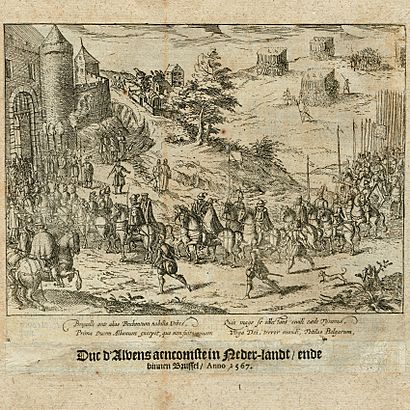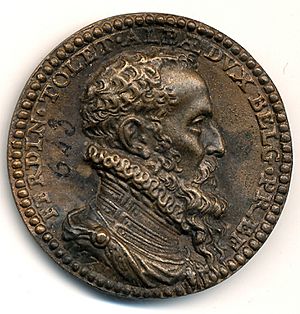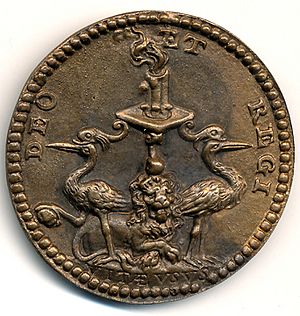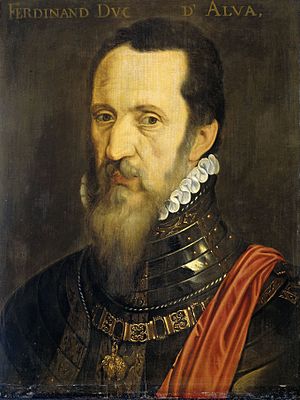Fernando Álvarez de Toledo, 3rd Duke of Alba facts for kids
Quick facts for kids
The Most Excellent
The Duke of Alba
|
|
|---|---|
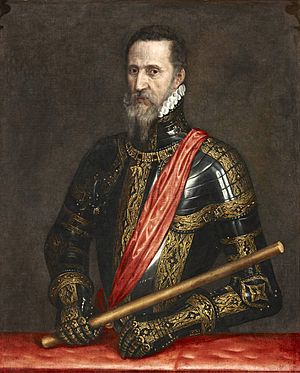
Portrait by Antonis Mor
|
|
| 12th Constable of Portugal | |
| In office 1581–1582 |
|
| Monarch | Philip I of Portugal |
| Preceded by | John, 6th Duke of Braganza |
| Succeeded by | Teodósio II, 7th Duke of Braganza |
| 1st Viceroy of Portugal and the Algarves | |
| In office 18 July 1580 – 11 December 1582 |
|
| Monarch | Philip I of Portugal |
| Preceded by | New title |
| Succeeded by | Archduke Alberto of Austria |
| Governor of the Netherlands | |
| In office 1567–1573 |
|
| Monarch | Philip II of Spain |
| Preceded by | Margaret of Austria |
| Succeeded by | Luis de Requesens y Zúñiga |
| Viceroy of Naples | |
| In office 1556–1558 |
|
| Monarch | Charles I of Spain |
| Preceded by | Bernardino de Mendoza |
| Succeeded by | Juan Fernández Manrique de Lara |
| Governor of Milan | |
| In office 1555–1556 |
|
| Monarch | Charles I of Spain |
| Preceded by | Ferdinando Gonzaga |
| Succeeded by | Cristoforo Madruzzo |
| Personal details | |
| Born | 29 October 1507 Piedrahíta, Ávila, Spain |
| Died | 11 December 1582 (aged 75) Lisbon, Kingdom of Portugal |
| Spouse | María Enríquez de Toledo y Guzmán |
| Children | Fernando de Toledo García Álvarez de Toledo y Enríquez de Guzmán Fadrique Álvarez de Toledo y Enríquez de Guzman Diego Álvarez de Toledo y Enríquez de Guzmán Beatriz Álvarez de Toledo y Enríquez de Guzmán |
| Profession |
|
| Signature |  |
| Military service | |
| Allegiance | |
| Rank | Captain General |
| Battles/wars | Four Years' War
|
Fernando Álvarez de Toledo y Pimentel (born October 29, 1507 – died December 11, 1582) was a very important Spanish noble, general, and diplomat. He was known as the Grand Duke of Alba in Spain and Portugal. In the Netherlands, people called him the Iron Duke because he was a tough leader.
He held many important titles, like the 3rd Duke of Alba de Tormes. He was also a Grandee of Spain, which is a very high rank for a noble. He was a Knight of the Order of the Golden Fleece, a special group of knights. His motto was Deo patrum nostrorum, which means "To the God of our fathers."
Fernando was a trusted adviser to two Spanish kings: Charles I of Spain (who was also Charles V, Holy Roman Emperor) and his son, Philip II of Spain. He served as a top official, like a chief of staff, for both kings. He was also a member of their important councils for state and war.
He held many powerful jobs across Europe. He was the governor of Duchy of Milan (1555–1556) and the viceroy of the Kingdom of Naples (1556–1558). He also governed the Spanish Netherlands (1567–1573) and became the viceroy of Kingdom of Portugal (1580–1582). He even helped arrange the marriages of King Philip II.
Many people consider him one of the best generals of his time. His soldiers respected him, even though he was strict. He would call them "gentlemen soldiers" in his speeches.
Alba first became famous during the Conquest of Tunis (1535). This was part of a long war between Spain and the Ottoman Empire. He also led Spanish troops to victory at the Battle of Mühlberg in 1547. In this battle, Emperor Charles's army defeated German Protestant princes.
In 1566, Pope Pius V gave him a special award called the Golden Rose. This was to thank him for his strong support of Catholicism.
He is most famous for his actions in the Dutch Revolt (also known as the Eighty Years' War). He set up a special court called the Council of Troubles to deal with rebels. He won many battles against the Dutch forces. However, his actions were very harsh, especially in cities like Mechelen, Zutphen, Naarden, and Haarlem. Even with his military success, the Dutch revolt continued, and he was called back to Spain.
His last big military success was in 1580. He won the Battle of Alcântara (1580) during the Portuguese succession crisis of 1580. This victory helped King Philip II of Spain also become King of Portugal.
Contents
Early Life and Education
Fernando was born in Piedrahíta, Spain, on October 29, 1507. His father, García, died in a military campaign when Fernando was only three years old. When he was six, Fernando joined his grandfather, the second Duke of Alba, on a mission to capture Navarre.
He grew up and was educated like other noble children in Spain. He studied at the Alba family's palace in Alba de Tormes. He had teachers from Italy and a Spanish poet named Juan Boscan. He learned about Catholicism and humanism. He became very good at Latin and also knew French, English, and German.
When he was 17, in 1524, he joined the army. He helped capture Fuenterrabía, a city that France and Navarre had taken. Because of his role in this battle, Fernando was made governor of Fuenterrabía.
In 1531, his grandfather died. Fernando then became the 3rd Duke of Alba. For the rest of his life, he served the Spanish kings, Charles I and Philip II.
Serving the Spanish Kings
In 1541, King Charles I of Spain made Fernando Álvarez de Toledo his chief steward. This meant he was a very important person in the king's court. He held this job until the king died in 1556.
In 1546, King Charles I also made Fernando a Grand Master of the Order of the Golden Fleece. This was a very special honor.
From 1548, King Charles started preparing his son, Philip, to become the next king. He made the Duke of Alba Philip's chief steward too. Fernando took Philip on a trip around Europe to help him learn. Fernando also went with Philip to England for his marriage to Mary Tudor in 1554.
After King Charles died, the new King Philip II kept Fernando as his chief steward. Fernando held this position until he died in 1582.
In 1563, King Philip II created a new title, Duke of Huéscar. This title was for the person who would inherit the Duke of Alba's title. Fernando's son, Fadrique, became the first Duke of Huéscar.
In 1566, Fernando's son, Fadrique, got into trouble. He broke a promise to marry a lady of the Queen. This led to him being arrested. He was later released to go to Flanders with his father for military service. Later, in 1578, it was found that Fadrique had secretly married someone else to avoid the first marriage. The Duke of Alba had allowed this. Because of this, Fadrique was sent to prison again. The Duke of Alba was also sent away from the court for a year for not following strict rules.
Military Leader
Early Battles (1532–1542)
After becoming the Duke of Alba in 1532, Fernando was sent to Vienna. He was there to help defend the city from an army from the Ottoman Empire. No battle happened, as the Ottomans decided to retreat.
During this time, he traveled with a soldier and poet named Garcilaso de la Vega. Because they were close, we know about the Duke's feelings from De La Vega's poems. These poems show how tough the travels were and how much Alba missed his wife.
The Duke's first real battle command was in the Conquest of Tunis (1535). This was a fight to take back Tunis from Hayreddin Barbarossa. Spain won, which helped them control the western Mediterranean Sea.
In 1542, he led Spanish troops against the French army. He ended the Siege of Perpignan (1542). This was a big victory for Alba and a major defeat for the French King Francis I.
Fighting in Germany (1546–1547)
In 1547, King Charles I (who was also Emperor Charles V) fought against Protestant forces in the Schmalkaldic War. The Duke of Alba led the Spanish troops, called Tercios, which were very skilled.
His troops played a key role in the Battle of Mühlberg. Their attack helped the Emperor's army win a major victory against the German Protestant princes.
Campaigns in Italy (1555–1559)
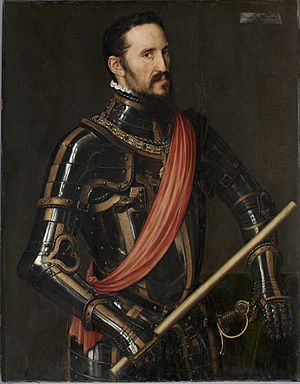
Later, the fighting between France and Spain moved to Italy. Alba was sent to Italy as the main commander of the Spanish army. He became governor of Milan in 1555 and viceroy of Naples in 1556.
The new Pope, Paul IV, did not like the Spanish rulers. He encouraged the King of France to remove the Spanish from Italy. The Pope even said that Philip II was no longer the King of Naples. Alba quickly marched his 12,000 Spanish soldiers towards Rome.
The Pope asked for a ceasefire, which gave a French army time to arrive. But the Spanish defeated the French in the Battle of St. Quentin (1557). Without French help, the Pope's troops were beaten. The Duke of Alba entered Rome in September 1557, and the Pope had to make peace.
In 1559, Alba helped sign the Treaty of Cateau-Cambrésis. This treaty ended the war with France. It brought a long period of peace to Italy.
Governor of the Netherlands (1567–1573)
In 1566, there was a period called the "Iconoclasm" in the Netherlands. During this time, groups of Calvinists attacked and destroyed many Catholic churches and statues. King Philip II sent Alba to Brussels in 1567 with a strong army to stop these rebels.
When he arrived, Alba took over from the king's sister, Margaret of Parma. He believed that the local nobles were rebelling against the king and supporting new Protestant ideas. He saw this as a serious problem.
On September 5, 1567, Alba created the "Council of Troubles." People in the Netherlands called it the "Court of Blood." This court was set up to punish those responsible for the riots. Alba also targeted Catholic nobles who wanted to talk things out instead of fighting. Two important Flemish nobles, the Count of Egmont and Philip de Montmorency, Count of Horn, were arrested. The court sentenced them to death. They were executed in Brussels in 1568. Alba watched the executions himself.
Keeping the army in Flanders was very expensive. So, the Duke decided to create new taxes. Some cities, like Utrecht, refused to pay and started a rebellion. This rebellion quickly spread across the Netherlands. William the Silent, a Dutch prince, started to actively support the rebels.
The Spanish army fought under banners that said Pro lege, rege, et grege. This means "For the law, the king, and the people." In 1572, the Spanish army took back and looted the city of Mechelen. They also retook Zutphen and Naarden. The Siege of Haarlem was very brutal. The city surrendered, and about 2,000 soldiers were executed. However, the Spanish failed to take Alkmaar. This was the first time Spanish troops were defeated in a major battle during the Dutch revolt.
The long wars and harsh punishments earned the Duke of Alba the nickname "The Iron Duke" in the Netherlands. His reputation was used by rebels to turn more people against Spain.
Even with all his military actions, the situation in the Netherlands was not getting better for Spain. After five years, more than 5,000 people had been executed. Many complaints reached the Spanish king. Philip II decided to change his approach and replace the Duke. He sent Luis de Requesens y Zúñiga to take over. Alba returned to Spain in 1573.
The Duke of Alba still had influence in the king's council. He was part of a group that believed in taking a very firm stand in the Netherlands. However, another group, led by Ruy Gómez de Silva, wanted to be more flexible. King Philip II himself later said that "it is not possible to carry Flanders forward by way of war." But when the new policies failed, Philip II again gave the Duke of Alba an important role in court.
Portuguese Succession (1580–1582)
In 1578, King Sebastian of Portugal died without any children. The crown then went to his great-uncle, Cardinal Henry I of Portugal. When Henry also died without heirs, it caused a problem over who should be the next king of Portugal in 1580.
One person who claimed the throne was António, Prior of Crato. He was declared King in June 1580. However, Philip II of Spain also had a claim to the throne through his mother.
King Philip II appointed Fernando, Duke of Alba, as the general of his army. The Duke was 73 years old and not well, but he gathered about 20,000 soldiers. In June 1580, he crossed into Portugal and marched towards Lisbon. In August, he defeated a Portuguese army at the Battle of Alcântara (1580). He then entered Lisbon. This victory allowed Philip II to become King of Portugal, uniting Spain and Portugal under one ruler.
King Philip II rewarded Fernando with the titles of 1st Viceroy of Portugal and Constable of Portugal on July 18, 1580. These titles meant Fernando represented the Spanish king in Portugal and was second in power only to the king. Fernando held both titles until his death in 1582.
Family Life

Fernando had his first child, Fernando de Toledo (1527–1591), with a miller's daughter.
On April 27, 1529, the Duke married his cousin, María Enríquez de Toledo y Guzmán. They had four children together:
- García Álvarez de Toledo y Enríquez de Guzmán (1530–1548)
- Fadrique Álvarez de Toledo y Enríquez de Guzman, who became the 4th Duke of Alba (1537–1585)
- Diego Álvarez de Toledo y Enríquez de Guzmán (1541–1583)
- Beatriz Álvarez de Toledo y Enríquez de Guzmán (died 1637)
Later Years and Death
Alba died in Lisbon, Portugal, on December 11, 1582. He was 75 years old.
His body was moved to Alba de Tormes in Spain, where he was first buried. Later, in 1619, his remains were moved to the Convento de San Esteban, Salamanca. In 1983, a special tomb was built for him there.
See also
 In Spanish: Fernando Álvarez de Toledo y Pimentel para niños
In Spanish: Fernando Álvarez de Toledo y Pimentel para niños


